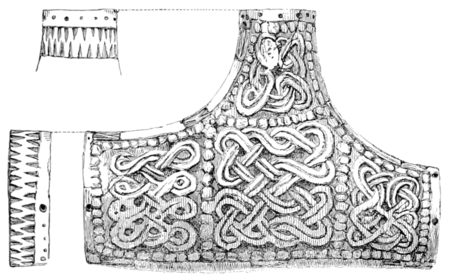as a type of the purse used from an early medieval period down to the fourteenth century, and it is not to be confounded (identity of shape resulting from the material employed), with powder horns resembling it in form, but of comparatively recent date; such a contrivance was in every way adapted for the preservation of the fragile bracteate money current among the people of Germany, Switzerland and Denmark. The period at which these horns and the treasure they contained were hidden, was possibly that when the Saracens made inroads towards the Grisons. M. Pfister observed that their devastations were noticed in a Swiss chronicle, under the year 950, during the residence of Bishop Hattbert at Chur.
A portion of a horn of similar shape, found with Roman coins and other remains, at Mansfield Woadhouse, in the county of Nottingham, is figured in the Archæologia[1]. It is now impossible to say that it was intended to serve the purpose to which M. Pfister's interesting relic was applied, as it is not described as hollowed out, but the similarity of form is remarkable. It was without any other ornament than a concentric circle on the stem of the fork.
PERIOD OF GOTHIC ART.
It is to be regretted that some years since most of the iron-work which, in the shape of screens or railings, protected the ancient monuments in Westminster abbey from the danger of a too close approach on the part of the public was taken down and deposited in a remote part of that edifice. Among the tombs so deprived of their original accessories may be mentioned that of Eleanor of Castile, consort of Edward the First. It was formerly separated from the adjoining aisle by a pierced iron screen of elaborate and elegant design; which is imperfectly represented in Carter's Architectural Antiquities, and earlier works, but no idea is there given of the beauty of its details. Mr. Willement lately submitted for inspection to the members of the Institute, at one of their monthly meetings, a cast of portion of this admirable work, of which, with his permission, an engraving is annexed, from the accurate pencil of Mr. Mac-
- ↑ Vol. viii. pl. xxiv.

